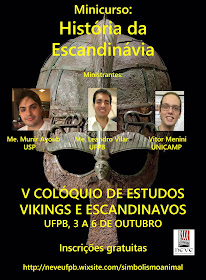História da Escandinávia
Objetivo geral: O minicurso se propõe a introduzir ao inscrito algumas reflexões iniciais de temas específicos da história escandinava como a Era Viking (793-1050), a invasão da Inglaterra pelos dinamarqueses (886-878) e o protagonismo político do Império da Suécia (1560-1718), a partir de aulas expositivas, leituras e discussões documentais. Cada um dos responsáveis pelo minicurso abordará temáticas paralelas a suas pesquisas atuais baseados em abordagens históricas ou arqueológicas e tópicos específicos como a política, sociedade e cultura.
Aula 1
(04 de outubro de 2017)
Prof. Me. Munir Lutfe Ayoub (MAE-USP/NEVE)
Os vikings são lembrados como invasores que destruíram e espalharam pavor por toda a Europa. No entanto, a historiografia e a arqueologia atual têm se esforçado para uma percepção maior desses povos e de suas sociedades. Nossa primeira aula, portanto, tem como objetivo específico pensar o conceito de “Era período Viking” (VIII-XI) e a diversidade de culto do mundo nórdico a partir do tratamento de fontes do período e suas problemáticas.
Bibliografia
ABRAM, Christopher. Myths of the Pagan North. Auckland: Continuum International Publishing Group, 2011.
ANDRÉN, Anders; JENNBERT, Kristina; RAUDVERE, Catharina. Old Norse Religion Some problems and prospects. In: ANDRÉN, Anders; JENNBERT, Kristina; RAUDVERE, Catharina. (Eds.). Old Norse Religion in long-term perspectives: origin, changes, and interactions. Lund: Nordic Academic Press, 2006. p. 11-15.
GANSUM, Terje; OESTIGAARD, Terje. The ritual stratigraphy of monuments that matter. European Journal of Archaeology, v. 7, n. 1, p. 61-79, 2004.
HEDEAGER, Lotte. Iron-Age Societies. Tradução de John Hines. Cambridge: Three Cambridge Center, 1992.
HODDER, Ian. The contextual analysis of symbolic meanings. In: HODDER, Ian. (Ed.). The Archaeology of Contextual Meanings. Cambridge: Cambridge University Press, 2009. p. 1-10.
SUNDQVIST, Olof. An Arena for Higher Powers. Cult Buildings and Rulers in the Late Iron Age and The Early Medieval Period in the Mälar Region. In: STEINSLAND, Gro et al. (Orgs.). Ideology and power in the Viking and Middle Ages Scandinavia, Iceland, Ireland, Orkney and the Faeroes. Boston: Leiden, 2011. p. 163-210.
Aula 2
(05 de outubro de 2017)
Prof. Me. Leandro Vilar Oliveira (PPGCR-UFPB/NEVE)
E-mail: vilarleandro@hotmail.com
O tema do segundo encontro será o processo de conquista de parte do território das ilhas britânicas pelos dinamarqueses (daneses) até a formação do Danelaw, parcela da área bretã governada pelos nórdicos. O século IX durante a Era Viking (VIII-XI) foi o período de maior expansão nórdica pelo continente europeu e Oriente Próximo. Nessa época, vários foram os processos de conquista e colonização, principalmente na Europa Ocidental. Entre estes acontecimentos destaca-se a conquista de parte da Inglaterra, durante os anos de 866-878, onde ocorreram as guerras da “Grande Armada Danesa” - o maior exército nórdico a invadir à Bretanha -, cujas conquistas resultaram na formação dos territórios ocupados pelos dinamarqueses e noruegueses até o século X.
Bibliografia
THE ANGLO-SAXON Chronicle. Translation Rev. James Ingram. London: Everyman Press Edition, 1912.
GRAHAM-CAMPBELL, James (org.). Os vikings. Barcelona: Folio S.A, 2006.
HADLEY, D. M. The Northern Danelaw. Its social structure, c. 800-1100. London/New York: Leicester University Press, 2000.
HAYWOOD, John. Historical Atlas of Vikings. London: The Penguin Books, 1995.
HEATH, Ian; MCBRIDE, Angus. The Vikings. London: Osprey Publishing, 1985. (Elite Series, 3).
KEYNES, Simon. The Vikings in England, c. 790-1016. In: SAWYER, Peter (ed.). The Oxford Illustrated History of the Vikings. New York: Oxford University Press, 1997. p. 48-82.
LOGAN, T. Donald. The vikings in the history. 2. ed. London/New York: Routledge, 1991.
STREISSGUTH, Thomas. Life among the Vikings. San Diego, CA: Lucent Books, 1999.
WINROTH, Anders. The Age of the Vikings. Princenton: Princenton University Press, 2014.
Aula 3
(06 de outubro de 2017)
Prof. Vítor Bianconi Menini (PPGH-Unicamp/NEVE)
E-mail: meninivitor@gmail.com
O terceiro encontro do minicurso tratará da experiência política da Suécia durante o século XVII, período conhecido pela historiografia como Stormaktstiden (“Era de grande poder”). Para isso, o resgate das raízes medievais do processo de centralização da Suécia será o ponto inicial da exposição. Os objetivos da aula serão compreender a construção e queda do Império sueco enquanto protagonista do cenário europeu após o Tratado de Vestefália e como esse movimento afetou aquela sociedade a partir da edificação do Estado moderno e seus desafios internos e externos.
Bibliografia
ANDERSON, Perry. Linhagens do Estado Absolutista. São Paulo: Editora Unesp, 2016.
CONTAMINE, Philippe. War and Competition between states. New York: Oxford University Press, 2000. (The origins of the Modern State in Europe).
GLETE, Jan. War and State in Early Modern Europe. New York: Routledge, 2002. (Warfare and History).
HALLENBERG, Mats; HOLM, Johan; JOHANSSON, Dan. Organization, Legitimation, Participation. Scandinavian Journal of History, Abigdon, v. 33, n. 3, p.247-268, out. 2008.
HAZARD, Paul. A Crise da Consciência Europeia. Tradução de Oscar de Freitas Lopes, Lisboa: Edições Cosmos, 1948.
LARSON, James. Reforming the North - The Kingdoms and churches of Scandinavia, 1520 – 1545. Cambridge: Cambridge University Press, 2010.
LINDEGREN, Jan. The Swedish ‘military state’, 1560–1720. Scandinavian Journal of History, Abigdon, v. 10, n. 4, p.305-336, dez. 1985.
LOCKHART, Paul. Sweden in the Seventeenth century. London: Palgrave, 2004.
NAUM, Magdanlena; NORDIN, Jonas M. Scandinavian Colonialism and the Rise of Modernity: Small Time Agents in a Global Arena. New York: Springer, 2013. (Contributions to Global Historical Archaeology).
PAGDEN, Anthony. Lords of all the World. New Haven & London: Yale University Press, 1995.
PARKER, Geoffrey. Global Crisis: War, Climate Change and Catastrophe in the Seventeenth Century. New Haven & London: Yale University Press, 2013.
REINHARD, Wolfgang [ed.]. Power Elites and state building. New York: Oxford University Press, 1996. (The origins of the Modern State in Europe).
ROBERTS, Michael. The Swedish Imperial Experience 1560 – 1718. 2. Ed. Cambridge: Cambridge University Press, 1984.
_______________. The Early Vasas: A History of Sweden 1523 - 1618. 2. ed. Cambridge: Cambridge University Press, 1986.
SCHILLING, Heinz. The European Crisis of the Early Seventeenth Century and the Birth of an International State System. In: IDEM, Early Modern European Civilization and its Political and Cultural Dynamism. (The “Menahem Stern Jerusalem Lectures”, 2006). Lebanon (New Haven): University Press of New England, 2008, p. 65-86 e 110-114.
Informações e inscrições clique aqui.

